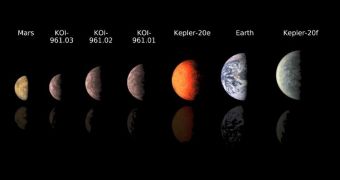Astronomers operating the NASA Kepler Telescope announce the discovery of not one, but three Earth-like planets in orbit around another star. Called KOI-961, the system is home to three worlds that are larger than Mars, but smaller than Earth.
Discovering such extrasolar planets is the primary reason why the Kepler mission was developed in the first place. The thing that makes astronomers tremble with excitement is the fact that all three of these new worlds are rocky, which is a very rare occurrence.
Only a handful of the 700+ exoplanets confirmed to date are known to be rocky. The issue with KOI-961.01, KOI-961.02 and KOI-961.03 (the names given to the three new worlds), is that they are located too close to their parent star to be habitable.
Early studies suggest that they are very hot, so that liquid water on their surface would evaporate immediately. Still, the fact that all are rocky is an encouraging sign, which speaks volumes as to the distribution of such planets among the stars.
The vast majority of the 2,300+ exoplanetary candidates Kepler proposed thus far are gas giants, most often hot Jupiters. There are very few rocky exoplanets the size of Earth, as most solid-surface objects are cataloged as super-Earths, proportionally speaking.
These new worlds are 0.78, 0.73 and 0.57 times the radius of Earth, respectively, which makes KOI 961.03 (the smallest of the lot) about the size of Mars. Kepler found them around one of the 150,000 stars it's continuously monitoring.
“Astronomers are just beginning to confirm thousands of planet candidates uncovered by Kepler so far. Finding one as small as Mars is amazing, and hints that there may be a bounty of rocky planets all around us,” NASA Headquarters Kepler program scientist Doug Hudgins says.
The three worlds were confirmed from Kepler data by a team of astronomers at the California Institute of Technology (Caltech), in Pasadena. Experts used the San Diego-based Palomar Observatory and W.M. Keck Observatory, on Mauna Kea, Hawaii, to conduct the verification study.
“This is the tiniest solar system found so far. It's actually more similar to Jupiter and its moons in scale than any other planetary system. The discovery is further proof of the diversity of planetary systems in our galaxy,” Caltech Exoplanet Science Institute principal investigator John Johnson concludes.

 14 DAY TRIAL //
14 DAY TRIAL //